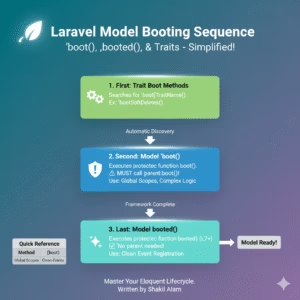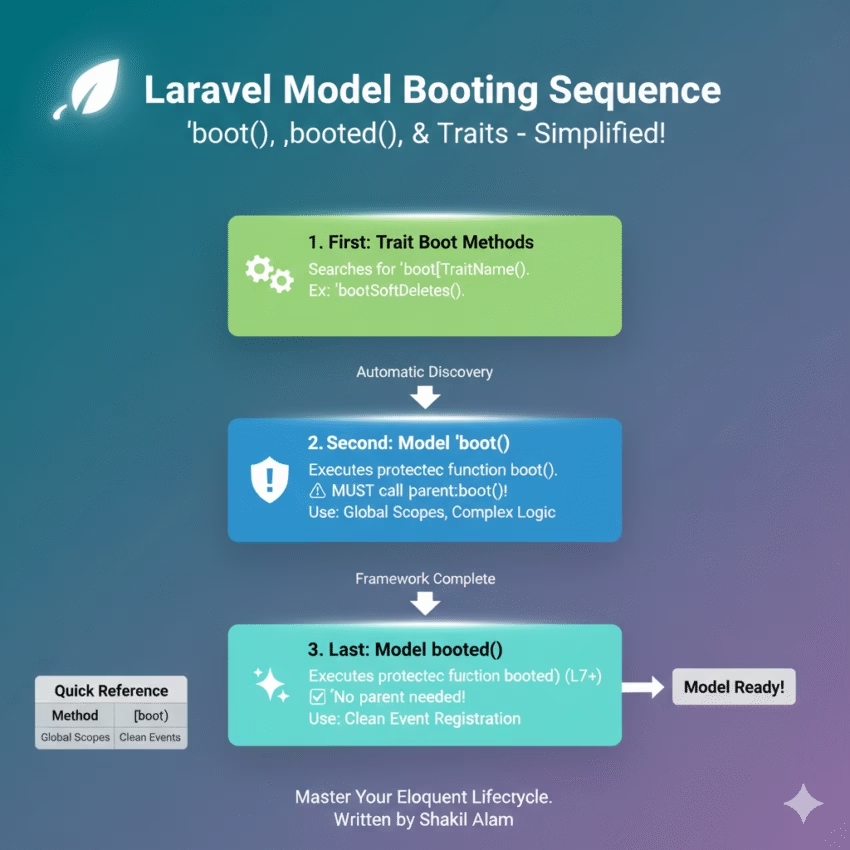Laravel is a framework that prides itself on elegance and clarity—but when it comes to model booting, many developers get confused between ,
, and even trait boots. If you’ve ever stared at an Eloquent model thinking, “Wait, when exactly is my event running?”, you’re in the right place.

This is your one-stop, no-fluff guide to understand, master, and use ,
, and
boot methods like a pro.
1. What is Model Booting in Laravel?
Every Eloquent model in Laravel has a lifecycle—from creation, update, deletion, and query-building.
Booting is the static process Laravel runs before the model class is fully ready to be used. It gives you crucial hooks to:
- Add static events (like
creating,updating,deleting) - Apply global scopes
- Initialize default attributes
Laravel’s boot process is flexible, but understanding the order is crucial to avoid “my event didn’t fire” moments.
2. Enter 
What it is:
boot() is a static method on the model itself. Override it when you need to add complex, model-level logic, or anything that requires the older, manual approach.
use Illuminate\Database\Eloquent\Model;
class Product extends Model
{
protected static function boot()
{
parent::boot(); // 🚨 Always call this
static::creating(function ($product) {
$product->uuid = (string) \Str::uuid();
});
}
}
Key Points
- Runs before
.
- Must call
parent::boot()to preserve trait and framework booting. - Ideal for global scopes and complex boot logic.
- Runs once per model class (static context).
- Historical Note: In early Laravel versions, this was the only way to register static model events.
3. Meet 
What it is:
booted() is a cleaner, safer alternative introduced in Laravel 7. It’s a static method that runs after the model has been fully booted.
use Illuminate\Database\Eloquent\Model;
class Product extends Model
{
protected static function booted()
{
static::creating(function ($product) {
$product->uuid = (string) \Str::uuid();
});
}
}
Why use ?
- Automatically chains logic—No need to call
parent::booted(), simplifying development. - Cleaner than overriding
for simple event registration.
- Runs after all trait
methods and the main model
.
- Safer when multiple developers add boot logic, as it avoids accidental overwrites.
4. Trait Boot Methods
Laravel doesn’t just call —it also calls trait boot methods automatically.
If a trait defines a method like , Laravel will automatically call it before the model’s
.
trait HasUuid
{
// Note: Method name must be 'boot' + 'TraitName' (camel-cased)
protected static function bootHasUuid()
{
static::creating(fn($model) => $model->uuid = (string) \Str::uuid());
}
}
class Product extends Model
{
use HasUuid;
}
Order of execution matters:
- All trait boots (
,
, etc.)
- Model
- Model
5. Visualization: The Boot Sequence
Here’s how Laravel actually runs things. This sequence is absolute:
[Traits boot* methods] -> [Model::boot()] -> [Model::booted()]
The Takeaway:
- Did you forget
parent::boot()? The sequence may break. - Did you rely on
but needed a global scope? Scopes need because they need to be applied earlier in the chain.
6. When to Use Which
| Method | Use Case |
Global scopes, complex boot logic, anything that needs parent::boot(). | |
| Simple events, cleaner alternative to overriding | |
| Trait boot | Shared logic across multiple models (e.g., UUID generation, Soft Deletes). |
7. Real-Life Example: Combining All
trait HasUuid
{
protected static function bootHasUuid() // Trait Boot
{
static::creating(fn($model) => $model->uuid = (string) \Str::uuid());
}
}
class Product extends Model
{
use HasUuid;
protected static function boot() // Model boot()
{
parent::boot(); // REQUIRED
// Logic here runs BEFORE booted()
static::creating(fn($product) => $product->slug = \Str::slug($product->name));
}
protected static function booted() // Model booted()
{
// Logic here runs LAST
static::created(fn($product) => logger("Product {$product->id} created!"));
}
}
Execution order:
sets
sets
logs creation
✅ All events happen in the right order, and nothing breaks.
8. Common Pitfalls
- Forgetting in
Trait boots won’t run, breaking features like Soft Deletes.
- Using for global scopes
It might run too late and the scope may not be applied to the initial query.
- Multiple developers overriding
Can overwrite each other’s logic;
avoids this problem.
9. TL;DR – The Million-Dollar Takeaway
- Trait
Run first.
- Model
Run second, required to call
.
- Model
Run last, perfect for event registration.
- Use the right tool for the job:
for global logic/scopes,
for cleaner event hooks.
Mastering this will make you the Laravel developer everyone asks for when something “doesn’t fire”.
10. Closing Thoughts
Understanding ,
, and trait boots is not just theory—it’s the difference between fragile code and rock-solid models.
By respecting the boot sequence and using where possible, you’ll write cleaner, safer, and easier-to-maintain Eloquent models.
